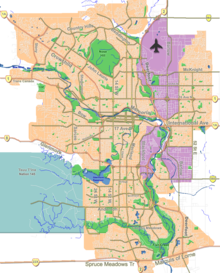Varsity, Calgary
| Varsity | |
|---|---|
| Neighbourhood | |
| Location of Varsity in Calgary | |
| Coordinates: 51°05′32″N 114°08′51″W / 51.09222°N 114.14750°WCoordinates: 51°05′32″N 114°08′51″W / 51.09222°N 114.14750°W | |
| Country |
|
| Province |
|
| City |
|
| Quadrant | NW |
| Ward | 1 |
| Established | 1963 |
| Government | |
| • Mayor | Naheed Nenshi |
| • Administrative body | Calgary City Council |
| • Councillor | Ward Sutherland |
| Area | |
| • Total | 6.2 km2 (2.4 sq mi) |
| Elevation | 1,110 m (3,640 ft) |
| Population (2006) | |
| • Total | 12,158 |
| • Average Income | $58,603 |
| Website | Varsity Community Association |
Varsity is an established neighbourhood in the Northwest quadrant of Calgary, Alberta. It was developed in the 1960s and early 1970s on a plateau to the north of the Bow River valley, and is primarily composed of Single-detached dwellings on wide lots. The neighbourhood comprises three major areas: Varsity Acres, Varsity Village, and Varsity Estates. Varsity is bounded on the north and east by Crowchild Trail, on the west by the Bow River, and on the south by 32nd Avenue NW. It borders the neighbourhoods of Silver Springs and Bowness on the west side, and both Montgomery and the University of Calgary campus on the south side. The easternmost portion of Varsity contains the University of Calgary Research Park.
Varsity Acres is the oldest part of Varsity. It was developed in the 1960s with a street pattern of folded grids, rear lanes, and the occasional cul-de-sac. The original access from the east was via Varsity Drive where it intersected at Crowchild Trail at Brisebois Drive. This access was closed in the early 1970s in favour of a connection to 40th Avenue NW at the same intersection.
Varsity Village was developed by Carma Developers LP in the late 1960s and early 1970s. Unique in Calgary, the planning of Varsity Village was based on the Radburn Plan by Clarence Stein and Henry Wright. The Radburn Plan adapted the ideas of the English Garden City to the increasingly motorised American context, developing a street hierarchy that segregated through traffic from local traffic and automotive traffic from pedestrican traffic. Like at Radburn, the developers of Varsity Village used as many culs-de-sac as possible, and forwent rear lanes in favour of pedestrian pathways that connected to parks behind the houses (and not adjacent to streets). The developers' intent was to create a park-like setting for users of the rear walkways, and in many places in the neighbourhood where tall private fences have not been built, this intent has been maintained.
...
Wikipedia

